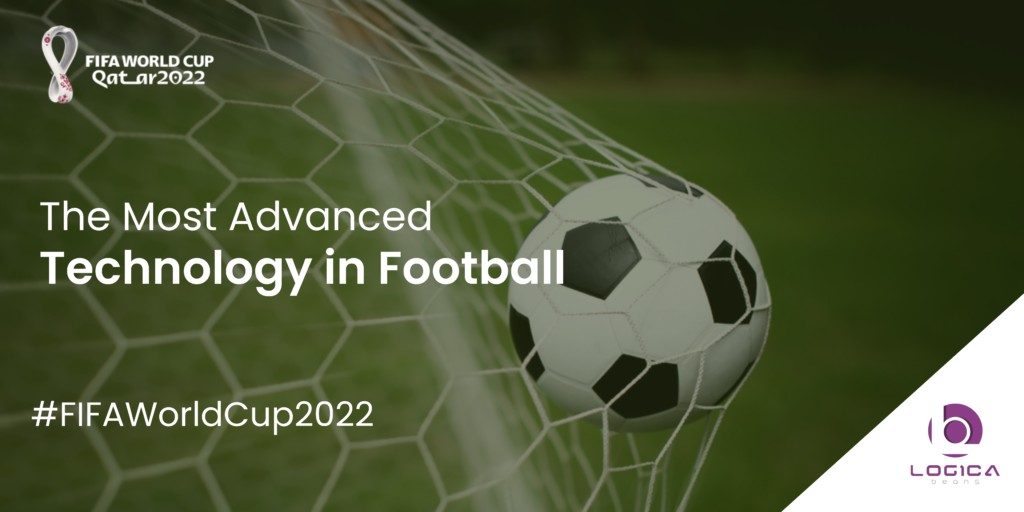The question of whether Ronaldo managed to make even the slightest contact with Bruno Fernandes’ in-swinging cross has generated controversy.
According to “extremely accurate” data obtained from a sensor within the match ball, Cristiano Ronaldo did not touch the ball during Portugal’s opening goal in their 2-0 victory over Uruguay.
All thanks to the 500Hz IMU sensor and Connected Ball Technology integrated into Adidas’ Al Rihla used in the competition.
Football is becoming more technologically advanced with an astonishing improvement to the system used for the World Cup in Qatar.
Every day, new technologies are developed and implemented, and the sporting world is no exception, particularly in football. FIFA is able to bring this vision to fruition at the FIFA World Cup 2022 by introducing and exploiting numerous innovations to enhance the football experience of soccer fans on both and off the field by embracing technology in football.
6 Advanced Technologies Qatar Implemented in FIFA 2022
Here are some of the advanced technologies Qatar Implemented in FIFA 2022:
1. Semi-automated offside technology
This year, FIFA revealed a unique semi-automated offside technology (SAOT) and utilized it at the FIFA World Cup 2022 in Qatar. This new system tracks every ball with 12 specialized surveillance cameras positioned beneath the stadiums roofs, as much as up to 29 data sets on each specific player, that is monitored 50 times every second, determining the precise placement on the ground. The 29 data points obtained cover all extremities and peripherals that are crucial for making offside calls. Integrating all of the information and data, they have employed sophisticated algorithms, an alert on a potential offside event will be given to video match referee in a structured manner.
2. Video assistant referee (VAR)
VAR is another technology we are excited to talk about. A video assistant referee (VAR) system is a technology that assists referees. In four game-changing scenarios, the VAR crew assists the referee’s strategic decision method. The video assistance referees crew regularly examines for blatant and evident faults linked to these four match-changing circumstances during a match.
The VAR staff only interacts with the referees when there are clear and evident errors or major missed situations. The group comprises of the visual referee (VAR) (green jersey, left to right) plus 3 assistance VARs (AVAR1 (second from right), AVAR2 (third from right), and AVAR3 (fourth form right) (standing). The VARs are used to review decisions made by the referee and determine whether a goal should count or not, if a player should be sent off, if there was a handball, if there was offside, and whether there is an infringement in the penalty area.
3. FIFA player app
FIFA created the FIFA Player App in partnership with FIFPRO, the global representation of professional players, based on feedback from professional athletes. The application will allow each player to see their personal player-performance data quickly afterwards each game. The additional measures offer novel and fascinating methods to analyze the game, such as the period of play, game-changing events, receiving positions, and pressure exerted to the person in possession.
Each individual player will have access to many action images captured during important stages of every World Cup match. The information gathered comprises improved football test and measurement, physical performance measurements, and improved football intelligence measurements.
4. Goal-line technology
It is one of the new technologies introduced by FIFA this year which is gaining the similar popularity like the VAR. Goal-line technologies is a technological method of identifying when the entire ball has passed the goal line in real time. The system must clearly show if the ball has completely passed the line. This data will allow the referee make their final verdict. The data is relayed in one second, ensuring an immediate response from the referee.
The system employs 14 elevated sensors located on the stadium’s catwalk/under the roof. The information from the sensors is utilized to produce a 3D animation that is shown to the audience on TV as well as on the stadium’s enormous display. On July 5, 2012, the IFAB agreed that the possible use of goal-line equipment would be incorporated into the Rules of the Game, and that a licensing procedure would be established to regulate the reliability of goal-line information system.
5. Football data ecosystem
Mostly in football world, information is a well-versed asset. Teams, journalists, presenters, and contest organizers require access to event and positional data for players, teams, and competitions. The objective of the live data collection method is to ensure the maximum potential information quality or diversity within a few seconds of the event on the field of play. This is accomplished by dividing the live data collection procedure into many operational processes, resulting in various layers of data. Skilled analysts, called as “speakers,” are present in the arena and spend their entire focus on what’s occurring in the pitch of play, communicating that data to the “author,” which enters the information into the program.
6. Technology to assist visually-impaired fans
This technology is Doha-based Bonocle founded by Abdelrazek Aly and Ramy Soliman in 2014. With the use of transcoding features and assistive technology, Bonocle will enable people with visual impairments to take part in and experience the World Cup in the same way as everybody else. Bonocle technology combined with Feelix Palm technology works together to provide complete football experience to the FIFA fans. Feelix will provide tactile palm transmitters to visually challenged fans so they may get braille-like messages during the games.
How these System Works?
If we closely analyze, the objective is to use various sorts of technology to enhance the match atmosphere for fans both on and off the field.
AI friendly remote identification assisted technology for visually challenged fans, stadium cooling technology, and cameras on the ball itself to determine peak game speeds are among the technologies available.
The last two FIFA World Cup have been dominated by advanced technologies. After Qatar was chosen to host the 2022 World Cup in 2010, the area they began developing Vision 2020-23 to highlight FIFA’s commitment to employing technology in football. Let’s check out how these technologies work.
The technological innovation, which combines limb- and ball-tracking information and employs artificial intelligence, sends an automatic vehicle offside alert to livestream match officials within the multimedia operating theater whenever the ball is received by an attacker who is in an offside position at the time the ball was played by a teammate.
Even though VAR has been heavily criticized for questionable calls in several leagues around the world, yet it has seen greater use throughout the years. Now, the system is known to have grown its usability and reliance over the years.
The SAOT scheme utilizes 12 devoted traceability sensors assembled beneath the club’s ceiling to monitor the ball and up to 29 pieces of data of each individual player 50 times a second, calculating their accurate location on the pitch, whereas the detector located in the center of the competition’s authorized game AI transmits information 500 times per second, enabling for highly specific identification of the start point.
Artificial intelligence evaluates the information acquired by sensors as well as the ball sensors in a matter of seconds to determine the offside scenario. If an offside situation is recognized, the SAOT system will send an automatic offside notice to the video game official’s crew.
Summary
- ● Technology has made an extraordinary impact on the game of football. It seems that the technological advancements will transform the playing field and the spectator experience.
- ● The most notable innovation was the Semi-automated offside technology which eliminated 95% of refereeing errors related to determining offside positions.
- ● Due to SAOT the World Cup Qatar 2022 will be one of the first cups where this innovation will be used to make sure teams play fair and accurately measure goals scored.
- ● It was claimed that the VAR system would offer a precise and unemotional interpretation of the event. VAR is not flawless, but it has made a significant impact in assisting officials in taking better decisions.
- ● FIFA is trying to add additional technologies to the data that governs close calls, such as offsides, scores, penalty decisions, and tackles.










